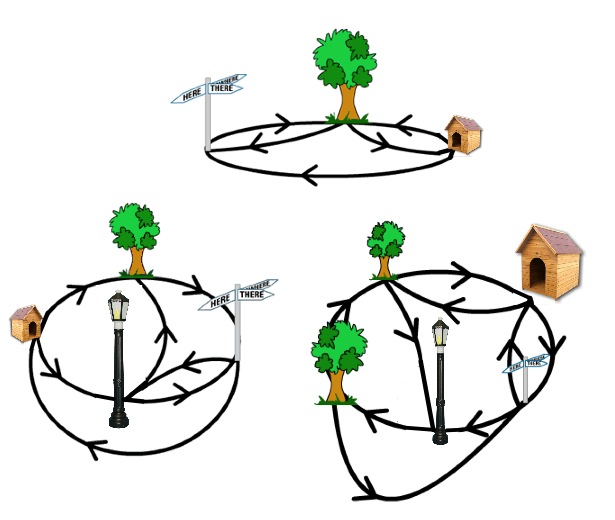Copyright © University of Cambridge. All rights reserved.
'Paw Prints' printed from https://nrich.maths.org/
Show menu
Why do this problem?
This problem requires pupils to use visualising, trial and improvement, and their own recording methods to get at solutions. The challenge may be unlike others they have seen in mathematics before, and this gives opportunities for all learners to shine.
Possible approach
Some pupils will enjoy and benefit from acting this out, so this might be a good place to start. You could draw the first 'map' on the playground with chalk, or use tape on the hall floor, with something being set up to represent each of the main landmarks (for example a chair or hoop). Explain the challenge to the group and ask them to talk in pairs about the dog's route. You could then
challenge one pair to demonstrate the route, perhaps with one of them walking it through. Did any pair have a different way?
Pupils could then work in smaller groups to have a go at the other routes. This sheet has a picture of each route. You may wish to allow groups to physically recreate the routes in the same way as you did as a whole class, but this is certainly not necessary - many will be able to use visualisation to plan the
dog's route. However they tackle the problem, encourage learners to find a way to represent their ideas so they remember their solutions.
In a plenary, you can share findings but in particular you can focus on how children approached the problem. Encourage pairs to explain how they found their solutions and draw attention to the differences and the similarities. For example, it is likely that some trial and improvement was used by more than one group, but it might have been through physically walking, through imagining what
would happen when the dog took certain paths, or through jottings. You could also encourage learners to share their different recording methods.
Key questions
How have you got to your solution?
Did you all agree?
What other ideas did you have?
How have you checked that it's ok?
What do you notice about the starting point each time?
How did you know the dog started there?
What do you notice about the finishing point each time?
How did you know the dog ended there?
If you count the number of pathways to and from each landmark, what can this tell you about the dog's route?
Possible extension
Pupils could be given the opportunity to create their own questions that are of a similar style. Having completed this challenge, learners could try The Bridges of Konigsberg.
Possible support
Annotating a print-out of this sheet might help some children work on the problem. Others will find it easier to physically walk it through and this may mean they require your help creating the map on the ground.
